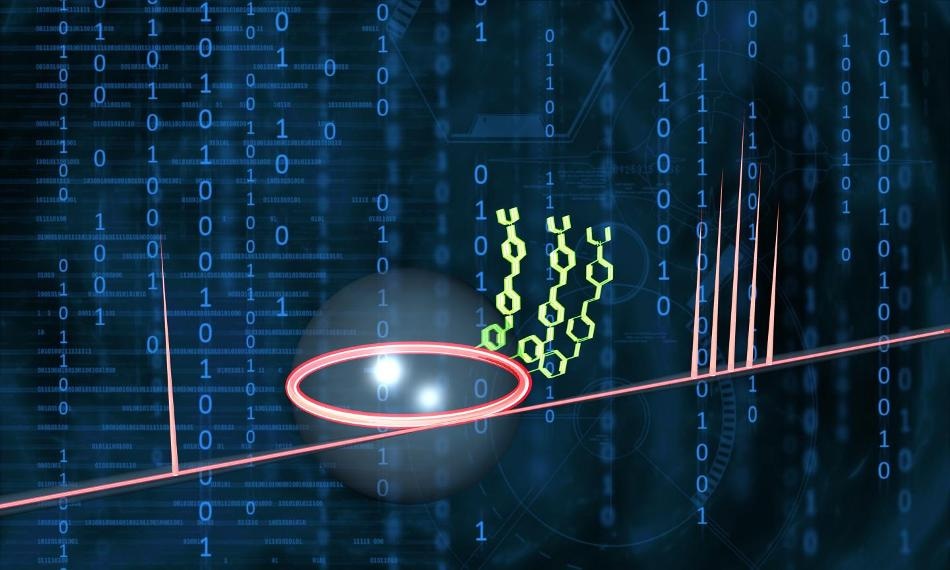Jan 15 2018
Data travels across miles of fiber optic cables, found running through the world's oceans, via pulses of light. According to experts, the data in these cables is at threat of being intercepted. However, a recently designed frequency comb, developed by researchers at the USC Viterbi School of Engineering, might be a successful tool for data encryption.
 (Photo credit: Vinh Diep and Alexa Hudnut)
(Photo credit: Vinh Diep and Alexa Hudnut)
Researchers Andrea M. Armani, Xiaoqin Shen, Rigoberto Castro Beltran, Vinh M. Diep and Soheil Soltani have invented a new technique to build a frequency comb - a tool that increases the probable applications of lasers by converting a single wavelength into several wavelengths. This effectively makes hundreds of lasers from a single laser. The new frequency comb is the size of a human hair compared with traditional frequency combs that can be as big as an apartment refrigerator. More significantly, the newly generated comb needs 1000x less power to work, allowing for mobile applications.
At present, we depend on material systems traditionally used in microelectronics, such as silicon. By substituting these materials with organic or carbon-based molecules, the team pursued a primarily different approach. Attaching just a single layer of a 25-atom organic molecule to the surface of a laser, frequency combs were displayed with 1000x reduction in power.
Professor Armani, the Ray Irani Chair in Engineering and Material Sciences at the USC Viterbi School of Engineering, compares the transition from conventional silicon to organic materials as equivalent to the transition of "gas to electric." At the most elementary level, the process that enables the comb to be produced is clearly different in the two material classes.
Organic optical materials have already transformed the electronics industry, leading to lighter, lower power TVs and cellphone displays, but previous attempts to directly interface these materials with lasers stumbled. We solved the interface challenge. Because our approach can be applied to a wide range of organic materials and laser types, the future possibilities are very exciting.
Professor Andrea M. Armani
Opportunity for Optical Encryption of Data:
The first applications of frequency combs concentrated on detecting trace quantities of chemicals and high precision time-keeping. However, in recent times, a new application of great importance to society has emerged: quantum cryptography.
Terms like quantum encryption and cyber security used to be the plot lines of action thrillers and Bond films, but with the arrival of crypto-currencies and IoT, the awareness of cyber security has moved from the motion picture to the mainstream. How can frequency combs be beneficial? The answer lies in how data is conveyed and how quantum cryptography functions.
When a data signal travels to its destination, it is packaged like a letter in a locked envelope. Just like any lock, some are simpler to crack than others and existing encryption efforts have concentrated on creating progressively complex and dynamic locks. However, one major limitation with many existing methods is that it is not possible to detect when an encryption has been futile.
Quantum encryption presents an alternative method. Not only can more multifaceted keys be implemented, but intrusions are instantly obvious through variations in the transmitted data signal.
While numerous strategies are being explored to enable quantum cryptography, one of the leading contenders is based on a phenomenon referred to as photon entanglement. Entangled pairs of photons must be produced at exactly the same time with precisely the same properties. Sound difficult? Enter frequency combs.
The main step in forming the frequency comb happens when the principal laser produces a secondary pair of wavelengths. However, due to of energy conservation, one wavelength must have higher energy and one wavelength must possess lower energy. Moreover, the energies must sum to be precisely equal to the principal laser and the two new wavelengths must appear at precisely the same time. Therefore, frequency comb generators can be seen as entangled photon generators.
While decreasing the size and power necessities of the frequency comb were main technical difficulties, there are numerous integration and manufacturing challenges remaining before quantum cryptography on portable systems will be common.
Armani, a faculty member in the new USC Michelson Center for Convergent Bioscience, showed that besides the vital role that quantum encryption could play in securing healthcare data in the future, frequency combs are also being used to enhance the detection of cancer biomarkers.